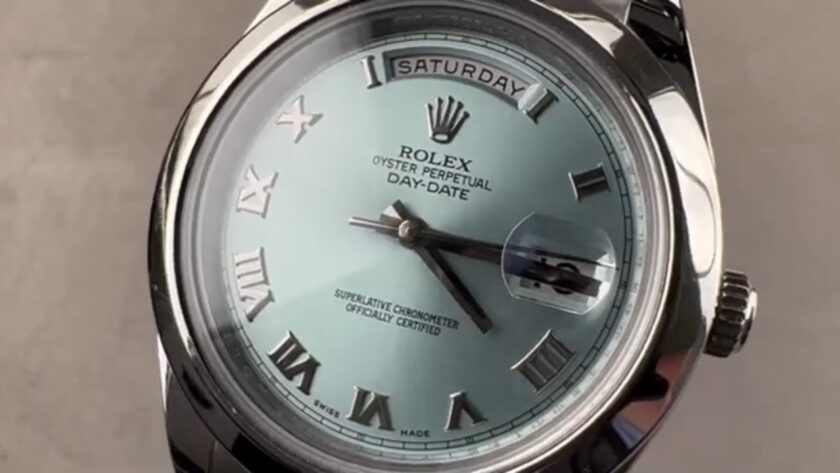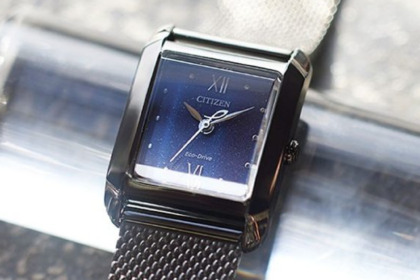Rolex Day-Date watches have a reputation for holding their value, with some references appreciating by up to 90% over the course of 2022. While these models resemble the previous Day-Date 36 President 118xx series, the newer caliber 3255 offers Double Quickset.
Since 1956 the Day-Date has distinguished itself as the ultimate dress watch, with dual apertures that display both the date and the day of the week spelled out in full. Unlike other Rolex watches, the Day-Date is exclusively available in precious metals.
Case
The Rolex Day-Date earned the nickname “The President” from being a timepiece of choice among several US presidents. Its prestigious allure and refined proportions speak volumes about the wearer’s success. The first model of the Day-Date Series, introduced in 1956, was the world’s very first watch to indicate both the date and the day of the week spelled out fully, changing simultaneously at midnight. This revolutionary feature has become a hallmark of the watch, which is why it still features prominently in its design to this day.
Over the years, the Rolex Day-Date has been offered in an extensive selection of dial colors, bezel types, and materials. This variety of options has allowed for collectors to find a Day-Date that perfectly suits their personal style and taste. The Day-Date is also available with a fluted or smooth bezel, and it can be embellished with precious gemstones.
Rolex has also been offering the Day-Date in various case finishes, including platinum and white gold. Platinum is an exceptionally durable and lustrous metal that is more expensive than white gold, but it exudes a more refined aesthetic. White gold, on the other hand, offers a more affordable and accessible option that still possesses a beautiful luster.
In the late 1980s, the Day-Date was updated with Caliber 3155, a movement that made it easier to set both the date and the day of the week. The new caliber also included a Double Quickset function that allows the wearer to change both displays without having to twist the crown for a full 24 hours.
The current 36mm Day-Date is an enduring icon, and its refined proportions make it a truly timeless piece. The Day-Date is offered in a wide variety of contemporary dial and bezel styles, and it is powered by the acclaimed cal. 3255 movement with a 48-hour power reserve.
The Day-Date is a truly versatile watch that can be worn with virtually any outfit, whether it’s casual or formal. It is a true testament to Rolex’s legacy of excellence and innovation. While the price of a Rolex Day-Date may be steep, it is well worth the investment for anyone who seeks to own a piece of luxury history.
Dial
Rolex has always been a master of high-impact visuals and the Day-Date is no exception. Its guilloche metallic blue dial is a visual feast for the eyes, with a radiant sunburst pattern that extends to the edges of the case and a knurled chapter ring. The dial is punctuated by a single diamond at 12 o’clock, Roman numerals, and cobalt baton hands. A double-quickset function allows the wearer to independently adjust the day and date displays.
In 2008, Rolex introduced the Day-Date II, a modern reinterpretation that catered to contemporary tastes and larger wrists. This incarnation maintained the essence of the original Day-Date while incorporating updated features and design elements. Both the Day-Date and the Day-Date II come in a variety of design variations including different bezels, metal options (yellow gold, white gold, or Everose) and case sizes. Unlike other Rolex models that offer steel or two-tone steel and gold options, the Day-Date is available only in precious metals.
It’s not difficult to see why the Rolex Day-Date was dubbed “the President’s watch” in 1965. US President Lyndon B. Johnson wore his yellow gold Day-Date model at the press conference following his gall bladder operation and it was a bold statement piece that captured the attention of millions.
Today, the Day-Date is still a powerful symbol of status and prestige, with its luxurious materials and prominent position on the wrist. It remains one of Rolex’s most recognized offerings and can be found in both 36mm and 41mm case sizes. The larger version is more contemporary, but Rolex continues to produce the smaller 36mm Day-Date for collectors who prefer a more traditional and understated look.
The Day-Date II’s movements are fully upgraded to meet the highest standards for horological excellence. Inside, the new Calibre 3255 provides a full suite of proprietary innovations that provide improvements in precision, autonomy, shock resistance, anti-magnetism and a 70 hour power reserve. As with all Rolex watches, the Day-Date II’s movements are assembled by hand in its Swiss factory. This meticulous craftsmanship makes the Day-Date II a timepiece that is not only functional, but also a joy to own and admire.
Bracelet
The Day-Date’s enduring status as the “power” watch of choice for world leaders, dignitaries, and other influential figures has earned it the nickname, “The President’s Watch.” The first Rolex to display the day of the week alongside the date in a window on its face, the Day-Date revolutionized timekeeping by providing an elegant and convenient means of determining the current date.
The 18078 is a relatively rare variant of the Day-Date II, which was introduced in 2008 as a modern reinterpretation of Rolex’s iconic flagship model that remained true to its original form and function. Whereas previous Day-Date models were 36mm, the 41mm case of the Day-Date II offered a bolder statement on the wrist, and still remains an ideal size for today’s fashion-forward tastes.
While both models share the same basic features, such as their Oyster cases, Triplock crown systems, and automatic movements, there are some notable differences. For starters, the 41mm Day-Date II has a fluted bezel — a design element that once served an functional purpose, but now serves merely as a beautiful aesthetic component that shimmers with the light when seen from certain angles.
Both models are crafted in precious metals, and both offer 100 meters of water resistance. In addition, the 41mm Day-Date II comes with a selection of gem-set hour markers that can be customized to fit the wearer’s personal style. The original Day-Date had a wide range of options as well, including baguette-shaped diamonds and special versions with two sapphire or ruby markers at 6 and 9 o’clock.
The Day-Date II’s bracelet is also an important point of difference compared to the traditional Day-Date, as it has a flat link design that is slightly thinner and lighter than the full-link, semi-honed, double-knotted bracelets found on many other Rolex watches. This makes it easier to move the watch around on the wrist without sacrificing its refined look and feel. The flat links are also a lot less likely to stretch over time, a common problem with Rolex’s older watches that have been worn for a long period of time.
Movement
The Day Date Series is a classic line of Rolex watches and is the first model to feature both the date and the day of the week on its dial. The watch was introduced in 1956 and has since become a fixture on the President bracelet. When you’re shopping for a used Rolex Day Date, be sure to do your research and learn about the watch you’re considering. This will help you understand what creates its value and make a smart buying decision.
The first generation of Day Date watches was the 6510 and 6511 series. These models are recognizable by the large arc-shaped window on their dial that displays the day of the week. This window can be changed in a number of different languages, making the Day Date a highly functional and versatile watch. These watches were also the first to be updated with the 3055 movement, which featured a quick-set date and other improvements.
In 2008, the Day Date II was released and replaced the previous model with a 41mm case. Like the older model, the new Day Date II featured a window on the dial that shows the day of the week and is available in 26 different languages. The Day Date II also features a Cyclops lens that magnifies the date at 3 o’clock. The Day Date II was also available in a number of metal finishes, including yellow gold and white gold.
In 2015, the Day Date II was replaced by the Day Date 40. While the two share more similarities than differences, the biggest change is that the Day Date 40 has a smaller 41mm case size and an updated movement. The Day Date 40 also offers a more balanced design and thinner bezel and lugs. This is a subtle upgrade to the classic status watch, but it’s still a great choice for anyone looking for a modern update to the iconic Rolex Day Date.





